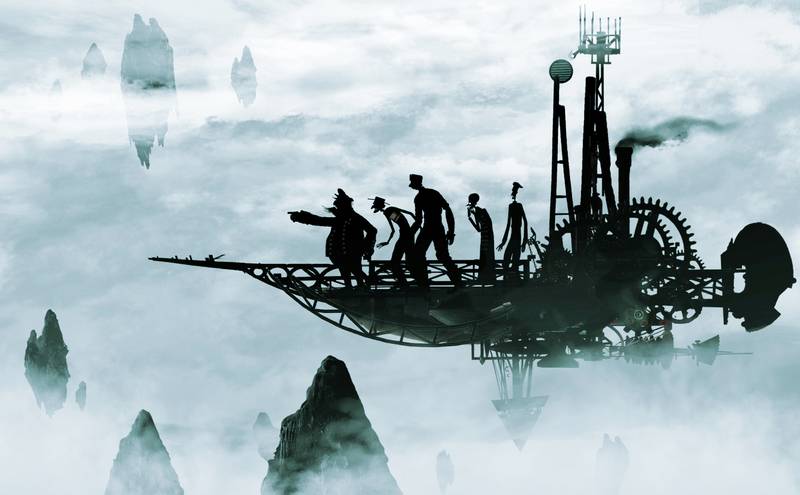Every year readers ask where they can see the Oscar nominees in the short film categories. This year, there’s an answer. The complete programs start Friday at the Gene Siskel Film Center in Chicago, and are now running in New York, Los Angeles, San Francisco, Detroit, Berkeley, Atlanta, Seattle and Denver. I’ve seen them all; here are capsule reviews:
“The Moon and the Son: An Imagined Conversation,” by John Canemaker and Peggy Stern (USA). Recreation of a painful relationship between a son and his angry father, who does prison time prison for arson. Photographs dissolve into animation that uses bold symbols and childlike drawings to create powerful emotions. The father and son (voiced by Eli Wallach and John Turturro) have an afterlife conversations where much is explained, nothing is resolved, and the pain continues, “I’m damned sure it’s not the film you hoped for,” the son says, “but it’s the conversation we could never have.”
“9” by Shane Acker (USA). In a futuristic world of ominous machinery and scraps of technology, humanoid creatures with camera lenses for eyes defend themselves against a fearsome mechanical ant. The sound track by David Steinwedel creates an atmosphere of creeping, crashing, menace. The warfare is elaborated as a game of hide and seek, beautifully animated and intriguingly unwholesome.
“Badgered,” by Sharon Colman (Great Britain) is a fable involving a badger, two crows, and an underground missile silo. The badger’s problems begin when he tries to silence the crows, scratches through the floor of his den and lands on the control panel of the missile launcher.
“One Man Band,” by Andrew Jimenez And Mark Andrews (USA) is from Pixar. In a town square in Europe, two one-man bands compete for the golden coin of a hard-to-please little girl. They one-up each other, with virtuosity and amazing musical tricks, but it’s a buyer’s market.
“The Mysterious Geographic Explorations of Jasper Morello,” by Anthony Lucas (Australia). A short that plays like an epic collaboration between H. G. Wells and Tim Burton. An extraordinary airship voyage in the steam age, through storms and shipwreck to an uncharted land where strange blood-eating creatures seem to offer the cure for a plague. The animation style is haunting and evocative, and the narration establishes the mood of eerie unknown.
“The Death of Kevin Carter: Casualty of the Bang Bang Club.” (Directed by Dan Krauss). The “Bang Bang Club” were the white South African photographers who covered the violence of apartheid. Kevin Carter won the 1994 Pulitzer Prize for a famous picture of a starving girl in the Sudan, being tracked by a vulture. He was criticized for not helping the girl. Carter increased his drug use, lost 18 crucial rolls of film, sank into depression, and killed himself. A friend regrets that he didn’t live to see the new South Africa; his daughter wonders if he died at the right time; the subtext is that drug addiction was the real problem.
“God Sleeps in Rwanda,” by Kimberlee Acquaro and Stacy Sherman. The 1994 massacre of one million Tutsis by the Hutu tribe left the country 70 percent female. We follow the lives of five women in the next decade. They tell of being raped and tortured; some become pregnant, many die of AIDS (drugs for the disease cost as much as a typical salary. A former Hutu government minister is charged, and her trial is the first to define rape as a war crime. One survivor studies law, another works as a tailor; the female majority is both a burden and an opportunity, as the nightmare of genocide still haunts the land.
“The Mushroom Club.” (Directed by Steven Okazaki). In Hiroshima, 60 years after the bomb, some remember, some forget. Vandals set fire to paper cranes left at the war memorial by children. Loudspeakers trucks prowl the streets, chanting militaristic slogans. Jet-skis and rock music mar the quiet of the Peace Park. We meet bomb survivor Keiji Nakazawa, whose anime film “Barefoot Gen” remembers the attack. And an old woman who was 15 when the bomb fell, and needed 27 operations to repair her face and her fused fingers. Another old woman combs the river banks for bits of fused steel and glass. And a woman whose parents were told it was their fault, and not the radiation, that caused their child to be born disabled. An annual ceremony remembers the tragedy, but many young people seem to have forgotten.
“A Note of Triumph: The Golden Age of Norman Corwin,” by Corinne Marrinan and Eric. Corwin, who still teaches at USC, was the producer of “On a Note of Triumph,” a historic 1945 radio broadcast on V-E Day. He appears along with others who remember the broadcast: Walter Cronkite, Robert Altman, Norman Lear, Studs Terkel. The night of the broadcast, “There was hope for the world,” Terkel says. “I can still recite most of it,” Altman says. Corwin was a poet who used radio as his medium. He recalls early days as a newspaperman, and how he created experimental radio simply because he didn’t know what couldn’t be done. The film stands as a rebuke to modern formula broadcasting.
“Our Time Is Up,” by Rob Pearlstein and Pia Clemente (USA). Kevin Pollack stars as a cold, detached psychiatrist who listens impassively as his clients complain of obsessive fondling, fear of the dark, fear of germs, bad relationships, and fear of turtles. Developments in his life inspire him to begin telling them the truth. They improve, and are grateful. A simplistic fable, competently made but hardly of Oscar caliber.
“The Last Farm,” by Rúnar Rúnarsson and Thor S. Sigurjónsson (Iceland). Spare, deeply moving: An old farmer and his wife are scheduled to enter a retirement home. It is their last few days on the farm. Using his skill as a farmer and ingenuity in his use of materials, he carries out one final task. The bleak photography complements the impassive performance by Jon Sigurbjornsson as the farmer.
“Cashback,” by Sean Ellis and Lene Bausager (Great Britain). Sean Bigerstaff plays an art student who works overnight at a supermarket. Time passes exceedingly slowly, and his boss is an oaf. Fellow employees hold scooter races and play dodgeball with milk cartons. He imagines he can freeze time, move unobserved among the staff and customers, and undress the women to sketch them for his art classes. Workday comedy edges into of imagination and eroticism.
“The Runaway” (Ausreisser), by Ulrike Grote (Germany). Walter (Peter Jordan) is an architect confronted by a small boy (Maximilian Werner) who wants to be taken to school. He has no idea who the boy is, but the boy follows him and calls him “father,” and it develops he may be Walter’s child by a former girlfriend. Walter tries to shake the kid but can’t. Where is the boy’s mother? Takes an unexpected turn that may please some but left me underwhelmed.
“Six Shooter,” by Martin Mcdonagh (Ireland). Brendan Gleeson is touching as a man whose wife dies in a hospital. On the train ride home across Ireland, he sits across from an obnoxious young man of heartless cruelty, who learns that the couple across the aisle have lost their baby. The kid is loud, obscene and cruel; how long can the others put up with him? The film ends in macabre developments, but what is remembered is Gleeson’s quiet suffering and the extraordinary inhumanity of the boy.
The programs play March 3-9 at the Siskel Center in Chicago. The live action and animation shorts play on a combined program Fri. at 5 and 8 pm, Sat. at 3 and 8:30 pm, Sun. at 2:30 pm, Mon. and Tue. at 5:30 pm, and Wed. and Thu. at 8 pm. The documentaries are Fri., Wed. and Thu. at 5:30 pm, Sat. at 6 pm, Sun. at noon and Mon. and Tue. at 8:15 pm.




















